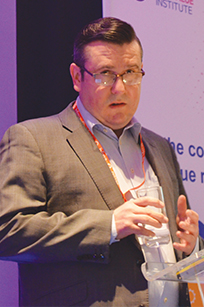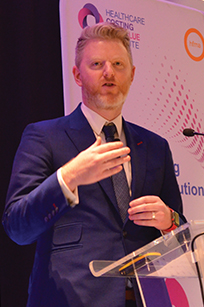Counting on costing
Key changes set out in the long-term plan and moves away from activity-based payment do not reduce the need for better cost data in the NHS. In fact, they make the current programme to get all NHS providers compiling and submitting patient-level costs even more important, according to the now joint pricing and costing team at NHS England and NHS Improvement.
 Chris Walters, the combined body’s director of pricing and costing, told the HFMA Healthcare Costing for Value Institute costing conference in April that good-quality costing underpinned all six of the themes in the long-term plan – from the development of new service models through to the delivery of value.
Chris Walters, the combined body’s director of pricing and costing, told the HFMA Healthcare Costing for Value Institute costing conference in April that good-quality costing underpinned all six of the themes in the long-term plan – from the development of new service models through to the delivery of value.
And despite the significant five-year settlement alongside the plan, improved efficiency would remain a major priority, especially in the light of rising demand, with cost data fundamental to identifying opportunities to drive this efficiency.
The direction of travel spelt out in the operational planning guidance also means a big role for costing, with changes under way to support system working and the introduction of a blended payment model for emergency care services.
Blended payment models – with a fixed payment linked to expected levels of activity and a volume-related element reflecting actual activity – are expected to be used more widely in the coming years for different areas of activity, moving the service away from strict payment by activity approaches.Increased focus
Over the years, costing has become linked in some people’s minds with the activity-based payment system, because cost data is used to set tariff prices. ‘But this [move to blended payment and system working] doesn’t reduce the need for costing,’ Mr Walters said. ‘It increases it, as the NHS will need to assess the true cost of care and understand any variation.’
to blended payment and system working] doesn’t reduce the need for costing,’ Mr Walters said. ‘It increases it, as the NHS will need to assess the true cost of care and understand any variation.’
Existing initiatives, such as Getting it right first time, NHS RightCare and the Model Hospital, are all keen to replace the existing reference cost data in their models and improvement tools with the more granular patient-level cost data.
Mr Walters said patient-level cost data had already informed work looking at the drivers of performance against the two-week cancer referral target. It was also being used in work around currency redesign, with same-day emergency care tariffs being a priority.
Mr Walters shared a platform with Model Hospital modelling lead Chris Rye and costing lead Jack Hardman. The team acknowledged that being able to look at outcome data alongside patient cost data was ‘high on the priority list’ and that the cost per weighted activity unit should ultimately be weighted on outcomes.
But even getting patient activity and cost data into one place across the whole patient pathway would be a step towards this.
‘Patient-level costing means we can see more of what happened to patients,’ said Mr Walters. ‘So, we could see things such as a patient coming back in the next day. That gives us a step towards outcomes.’
If current plans with the costing transformation programme – newly renamed simply as National Cost Collections – proceed as planned, in two years the whole of the English NHS could be making a costing submission at patient level, covering all services. Acute trusts face their first mandatory collection this summer, although 80 trusts last year took part in a voluntary submission. Mental health and ambulance trusts will also be required to submit their patient-level costs in 2020, covering 2019/20 costs. And although not yet mandated, it is expected that community providers will join the submission in 2021.
This will give a powerful data source to inform decision-making across integrated care systems as it will enable patient costs to be seen across whole patient journeys, not simply within specific organisations or sectors. Trusts delivering community services perhaps face the biggest challenges in meeting the likely 2021 deadline for submitting costs. For some organisations, these challenges are around incomplete activity data needed to correctly allocate costs to individual patients and the systems to support this – although there are also concerns about whether organisations have the right IT infrastructure in place to support the costing process (see box overleaf).
Gloucestershire Care Services NHS Trust is one of the trusts most advanced in this sector – one of NHS Improvement’s roadmap partners helping to test out the costing process. It has made significant progress helped by relatively recent acquisitions of a new clinical and costing system and mobile devices for clinical staff.
 Steven Wainwright, trust commercial manager, said the motivation for community trusts was just as strong as for other sectors. ‘We want more granularity for our in-house reports and to understand episodes of care,’ he said, adding that the lowest cost contacts were not necessarily delivering the best value. Understanding these costs by team and locality was also important.
Steven Wainwright, trust commercial manager, said the motivation for community trusts was just as strong as for other sectors. ‘We want more granularity for our in-house reports and to understand episodes of care,’ he said, adding that the lowest cost contacts were not necessarily delivering the best value. Understanding these costs by team and locality was also important.
He said executive level sponsorship was crucial – in Gloucestershire’s case, coming from the finance director. But he offered other lessons for trusts embarking on their own programmes. ‘Have a strong relationship with your software supplier. Familiarise yourself with the technical documents – there is a lot to get your head around. And identify some quick wins to demonstrate the potential,’ he said.
He also warned against looking for perfection. ‘If you can get up to 70% right, it is enough to start the cycle of improvement,’ he said. He encouraged community providers to get on with the finance ledger to cost ledger mapping, which was a ‘lot of work’ but was broadly a one-off exercise and crucial to getting accurate cost data.
‘Engage stakeholders and share the results early,’ he said. ‘And it is an iterative process, so the sooner you start the better.’
Collective effort
Getting to the position where all providers are collecting and submitting patient-level costs is a major undertaking. But the point of costing is to use the information to improve decision-making.
Wrightington, Wigan and Leigh NHS Foundation Trust is relatively well advanced in using patient-level data. Its work was recognised last year, when it won the HFMA Costing Award. And the trust’s costing team talked the conference through its patient-level costing journey.
Although this started back in 2009 – and the trust has won plaudits in its costing audits – it knew there was room for improvement and in particular targeted better engagement with clinical teams.
Faced with a raft of typical responses – including complaints that the data was too complicated and concerns about the allocation of overheads – the trust embarked on a major education and awareness-raising exercise.
Gaining executive buy-in to a Maximising contribution programme, the team demonstrated how service line reporting, costing and Model Hospital data could be used to identify opportunities for service improvement. Divisional leads were involved in validating the data and this has led to better acceptance of the data and to changes in process – for example, in terms of how theatre time is allocated and the costs used for different prostheses. Checks have also been built into the system to ensure input errors do not lead to meaningless results.
The programme has identified big savings and the cost data has been used in local tariffs to support a joint venture business case and as the basis for challenge on trauma and orthopaedic complex revision prices.

‘Engagement is a continual process,’ Naomi Simpson, the trust’s cost accountant told the conference. ‘It is about getting and then keeping people interested.’ A recent initiative to support this has seen the creation of a costing club for clinicians and managers to discuss costing.

Michael Harrison, SLR accountant at Wrightington, Wigan and Leigh, added that getting champions for costing can make a difference. ‘If you get even one person in a key role outside costing, that can raise the profile and open doors,’ he said, urging colleagues to spend more time on engagement and less on fine-tuning the costing model. ‘It is about finding the right people who understand the importance of working with the costing team,’ he said. ‘Persevere until you find them.’
The programme to introduce comprehensive patient-level costing across the English NHS has already been a long slog. And there’s still plenty to do before robust costing data exists covering the whole patient pathway. But with the first mandatory collection for acute trusts in 2019, the programme has reached a milestone.
Big challenges still lie ahead in producing comprehensive data that is comparable across organisations and across systems. But the biggest
is starting to use the data to inform clinical decision-making and getting this embedded in practice across the service.
The right hardware
NHS England and NHS Improvement (the new, single-organisation name for the formerly separate bodies) is reminding NHS trusts of the importance to review their IT hardware infrastructure to ensure it can meet the requirements placed on it by the new patient-level costing standards.
This year, acute trusts will make their first mandatory submission of patient-level cost data for National Cost Collections, using the national NHS’s consistent, centrally set methodology.
An increasing number of trusts have been making voluntary submissions in recent years, but this year’s submission – based on 2018/19 cost data for admitted patient care, outpatients and A&E services – will be the first time that all acute trusts have submitted patient-level costs during a mandated submission window. They will be joined by mental health trusts and ambulance trusts next year (for 2019/20 data).
As for community trusts, there is a consultation currently being undertaken with the aim that they will be mandated to make their first submissions in 2021.
In getting to this stage, much of the focus has been on revising local costing processes to align with the new methodology and on the software needed to support these processes.
However, the sheer scale of the new collection process puts a much greater demand on the IT infrastructure, which has traditionally been required by finance teams to prepare and submit reference costs.
 ‘We have six million records for the collection of reference costs across the whole sector,’ says Jack Hardman, costing lead at NHS England and NHS Improvement.
‘We have six million records for the collection of reference costs across the whole sector,’ says Jack Hardman, costing lead at NHS England and NHS Improvement.
‘But now we have a more than ten-fold increase in the data set. For instance, for just 80 acute trusts submitting patient-level cost data last year as part of the voluntary scheme, we have three billion records.’
‘There is a significant quantity of data and an increase in the volume of validations we need providers to do to ensure we get the right data quality,’ adds fellow costing lead Candice Goold. ‘If trusts have not allocated the right hardware to their costing practitioners, it significantly slows down the costing process.’
In some cases, the process of allocating overheads to patient-facing or support cost centres and then on to patients has been taking up to 17 hours.
There have also been reports of costing teams borrowing more powerful computers, or running on multiple computers, to enable the process to be run.
The problems are perceived to be with both computers and servers.
NHS England and NHS Improvement appreciates that capital funds are currently in short supply and that this makes it challenging to invest in the necessary IT infrastructure to be able to meet the mandatory submission requirements.
However, Mr Hardman says that trusts can expect a good return on their investment.
‘I’m working with one organisation currently that has invested less than £1m and has found £4m of recurrent savings,’ he says. ‘Organisations need to consider the opportunities to invest to save.’
These savings come from the ability to embed the use of patient-level cost data across the organisation.
‘If you can’t run the costing processes quickly and accurately – for example the 17-hour model – then an organisation is not going to ask you to run the data monthly,’ Mr Hardman adds.
This might leave organisations looking at patient cost data on a yearly basis, long after it has lost its patient-specific meaning to clinicians who can use up-to-date granular data to optimise pathways.
Mrs Goold believes that the biggest concern now is the community sector. ‘Many community trusts may not have the hardware available to collect the data,’ she says. ‘The need to comply with – and to benefit from – costing requirements is likely to be coming down the road really quickly.’
Related content
We are excited to bring you a fun packed Eastern Branch Conference in 2025 over three days.
This event is for those that will benefit from an overview of costing in the NHS or those new to costing and will cover why we cost and the processes.